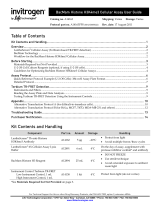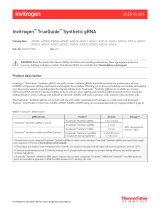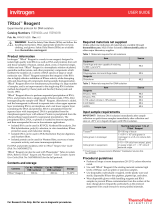Page is loading ...

Total Exosome Isolation (from serum)
Publication No. MAN0006950 Rev. Date: 28 June 2012
Catalog Number: 4478360 Store at 2°C to 8°C
Product Description
Exosomes are small vesicles (30–120 nm) containing RNA
and protein that are secreted by various types of cells in
culture, and found in abundance in body fluids including
blood, saliva, urine, and breast milk. Exosomes are thought
to function as intercellular messengers, delivering their cargo
of effector or signaling macromolecules between specific
cells, however, their formation, the makeup of the cargo, and
biological pathways in which they are involved remain
incompletely understood.
The biological study of exosome function and trafficking
requires the isolation of intact exosomes, but the current
methods used are tedious, non-specific, and difficult. The
Total Exosome Isolation (from serum) reagent provides a
simple and reliable method of concentrating intact exosomes
from blood serum samples. By tying up water molecules, the
Total Exosome Isolation (from serum) reagent forces less-
soluble components (i.e. exosomes) out of solution, allowing
them to be collected after brief, low-speed centrifugation.
Product Contents
Total Exosome Isolation (from serum) reagent contains
reagents sufficient for processing 30 mL of serum.
Component Amount Storage
Total Exosome Isolation
(from serum) 6 mL 2°C to 8°C
General Guidelines
• The Total Exosome Isolation (from serum) reagent is not
recommended for isolation of exosomes from plasma.
Exosome preparations derived from plasma samples are
of lower quality because plasma contains high levels of
clotting factors that will co-precipitate with the
exosomes and result in a large pellet that is difficult to
resuspend.
• If you are isolating intact exosomes from cell culture
media, use the Total Exosome Isolation (from cell
culture media) reagent.
• After exosomes are isolated, total RNA and protein can
be purified using the Total Exosome RNA and Protein
Isolation Kit.
• To isolate exosomal proteins for immunoprecipitation,
use Exosome Immunoprecipitation (Protein A) or
Exosome Immunoprecipitation (Protein G).
Prepare Sample
1. Remove the serum sample from storage and place it on ice.
If the sample is frozen, thaw the sample in a 25°C water
bath until it is completely liquid, and place on ice until
needed.
2. Centrifuge the serum sample at 2000 × g for 30 minutes to
remove cells and debris.
3. Transfer the supernatant containing the clarified serum to a
new tube without disturbing the pellet, and place it on ice
until ready to perform the isolation.
Isolate Exosomes
1. Transfer the required volume of clarified serum to a new
tube and add 0.2 volumes of the Total Exosome Isolation
(from serum) reagent.
Serum Reagent
100 µL 20 µL
1 mL 200 µL
2. Mix the serum/reagent mixture well either by vortexing or
pipetting up and down until there is a homogenous
solution.
Note: The solution should have a cloudy appearance.
3. Incubate the sample at 2°C to 8°C for 30 minutes.
4. After incubation, centrifuge the sample at 10,000 × g for
10 minutes at room temperature.
5. Aspirate and discard the supernatant. Exosomes are
contained in the pellet at the bottom of the tube.
6. Use a pipette tip to completely resuspend the pellet in a
convenient volume of 1X PBS or similar buffer.
Starting Serum Volume Resuspension Volume
100 µL 25–50 µL
1 mL 100–500 µL
7. Once the pellet is resuspended, the exosomes are ready for
downstream analysis or further purification through affinity
methods.
Keep isolated exosomes at 2°C to 8°C for up to 1 week, or at
≤20°C for long-term storage.
Product Use: For research use only. Not for human or animal therapeutic or diagnostic use.

www.lifetechnologies.com
Related Products
Product Cat. No.
Total Exosome RNA and Protein Isolation Kit 4478545
Total Exosome Isolation (from cell culture media) 4478359
Exosome Immunoprecipitation (Protein A)
10610D
Exosome Immunoprecipitation (Protein G ) 10612D
Limited Use Label License: Research Use Only
The purchase of this product conveys to the purchaser the limited, non-transferable right to use the purchased amount of the product only to perform
internal research for the sole benefit of the purchaser. No right to resell this product or any of its components is conveyed expressly, by implication, or
by estoppel. This product is for internal research purposes only and is not for use in commercial applications of any kind, including, without
limitation, quality control and commercial services such as reporting the results of purchaser’s activities for a fee or other form of consideration. For
information on obtaining additional rights, please contact outlicensing@lifetech.com or Out Licensing, Life Technologies, 5791 Van Allen Way,
Carlsbad, California 92008.
Limited Product Warranty
Life Technologies Corporation and/or its affiliate(s) warrant their products as set forth in the Life Technologies’ General Terms and Conditions of Sale
found on Life Technologies’ website at www.lifetechnologies.com/termsandconditions. If you have any questions, please contact Life Technologies
at www.lifetechnologies.com/support.
LIFE TECHNOLOGIES CORPORATION AND/OR ITS AFFILIATE(S) DISCLAIM ALL WARRANTIES WITH RESPECT TO THIS DOCUMENT, EXPRESSED OR
IMPLIED, INCLUDING BUT NOT LIMITED TO THOSE OF MERCHANTABILITY, FITNESS FOR A PARTICULAR PURPOSE, OR NON-INFRINGEMENT. TO THE
EXTENT ALLOWED BY LAW, IN NO EVENT SHALL LIFE TECHNOLOGIES AND/OR ITS AFFILIATE(S) BE LIABLE, WHETHER IN CONTRACT, TORT,
WARRANTY, OR UNDER ANY STATUTE OR ON ANY OTHER BASIS FOR SPECIAL, INCIDENTAL, INDIRECT, PUNITIVE, MULTIPLE OR CONSEQUENTIAL
DAMAGES IN CONNECTION WITH OR ARISING FROM THIS DOCUMENT, INCLUDING BUT NOT LIMITED TO THE USE THEREOF.
©2012 Life Technologies Corporation. All rights reserved. The trademarks mentioned herein are the property of Life Technologies Corporation or their
respective owners.
/










